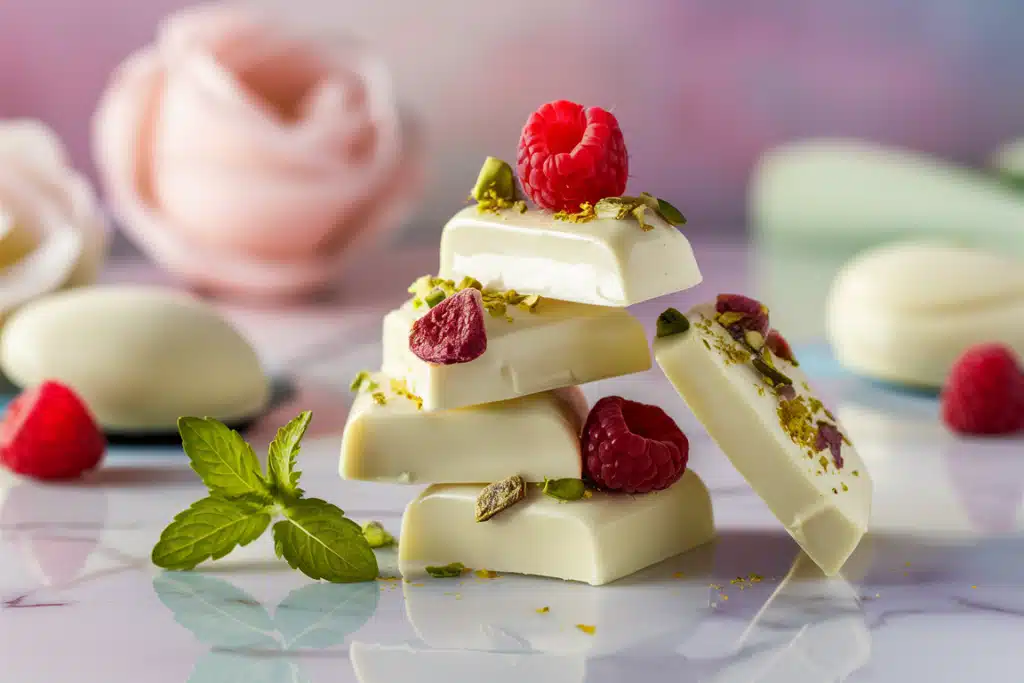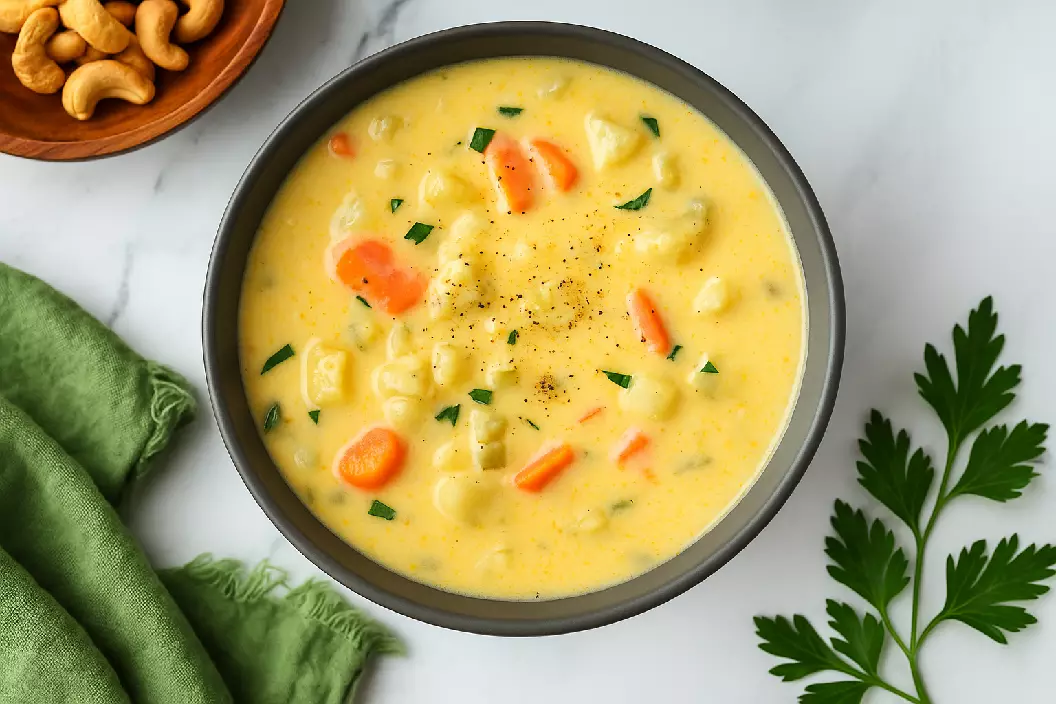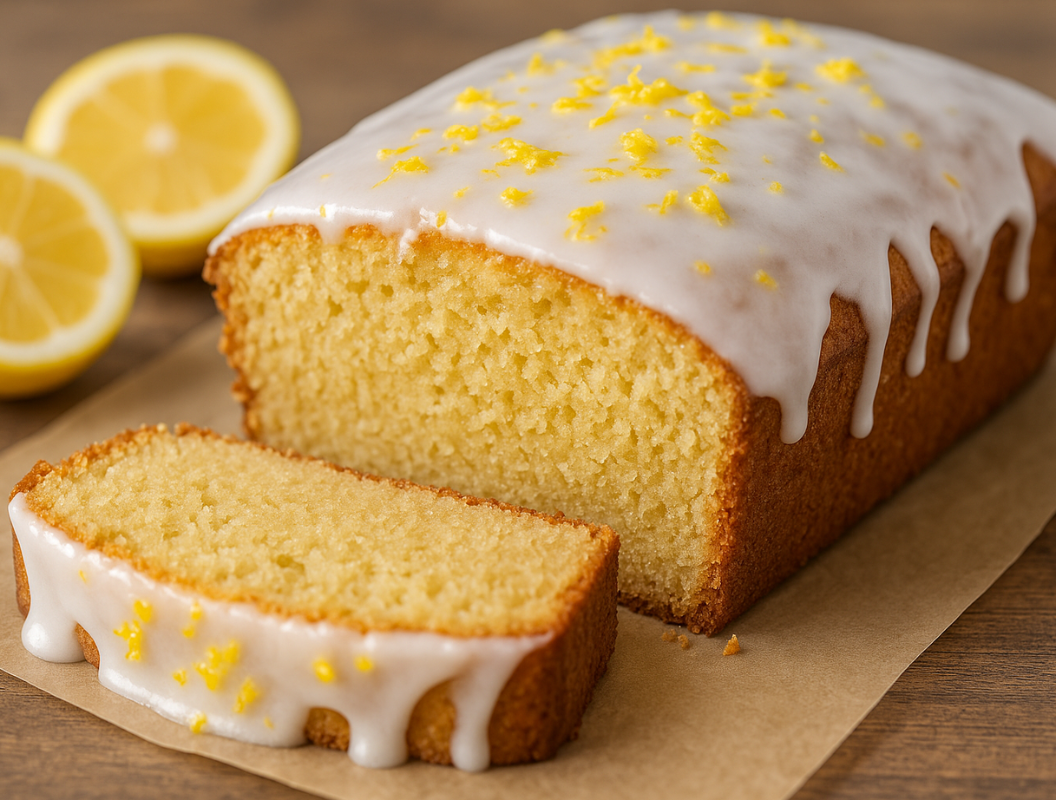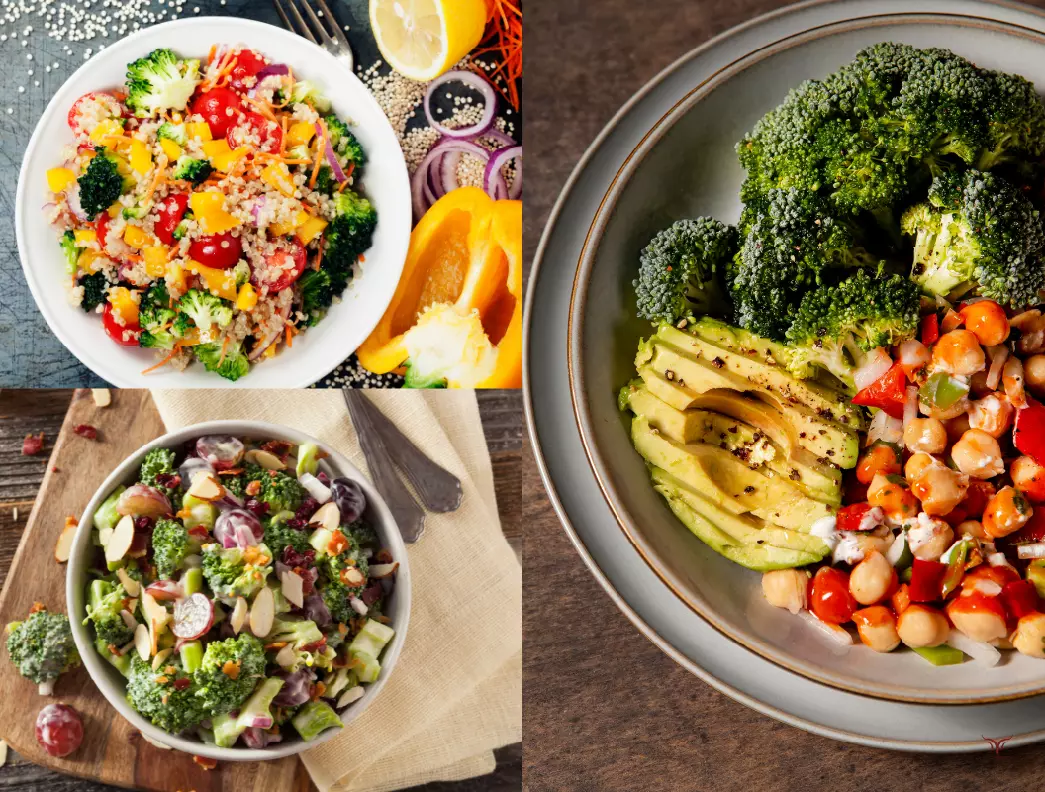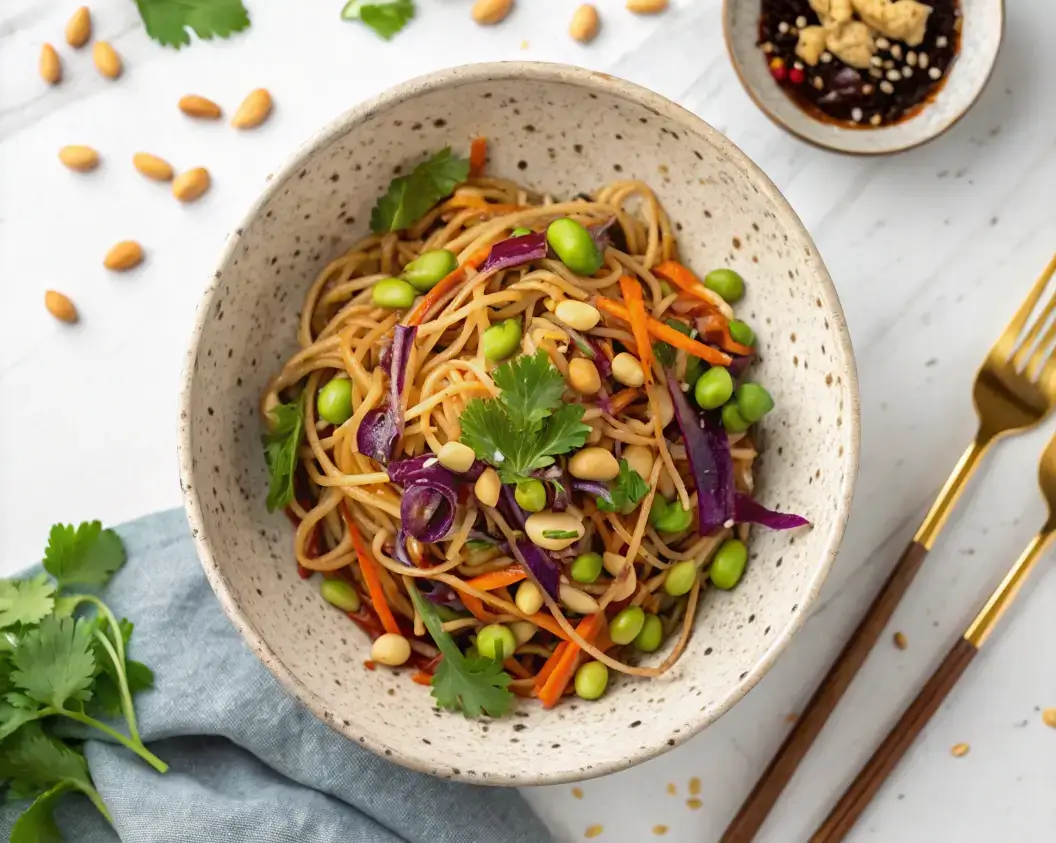Ever craved the creamy, luxurious taste of white chocolate but found yourself limited by dietary restrictions? You’re not alone. For years, vegans and dairy-sensitive individuals have had to pass up this sweet indulgence – until now.
Imagine creating your own silky-smooth, melt-in-your-mouth white chocolate with just 5 simple ingredients. No dairy, no complicated processes, and definitely no compromising on taste. Making your own vegan white chocolate is not just a tasty dessert. It also creates new options for those who thought they had to give up this favorite sweet.
In this comprehensive guide, we’ll walk you through everything you need to know about crafting the perfect vegan white chocolate at home. You will find everything you need, from key ingredients and tools to simple instructions and fun variations.
Making this dairy-free treat is easy! Let’s dive into the world of vegan white chocolate making and unleash your inner chocolatier!

Essential Ingredients
Raw Cacao Butter Basics
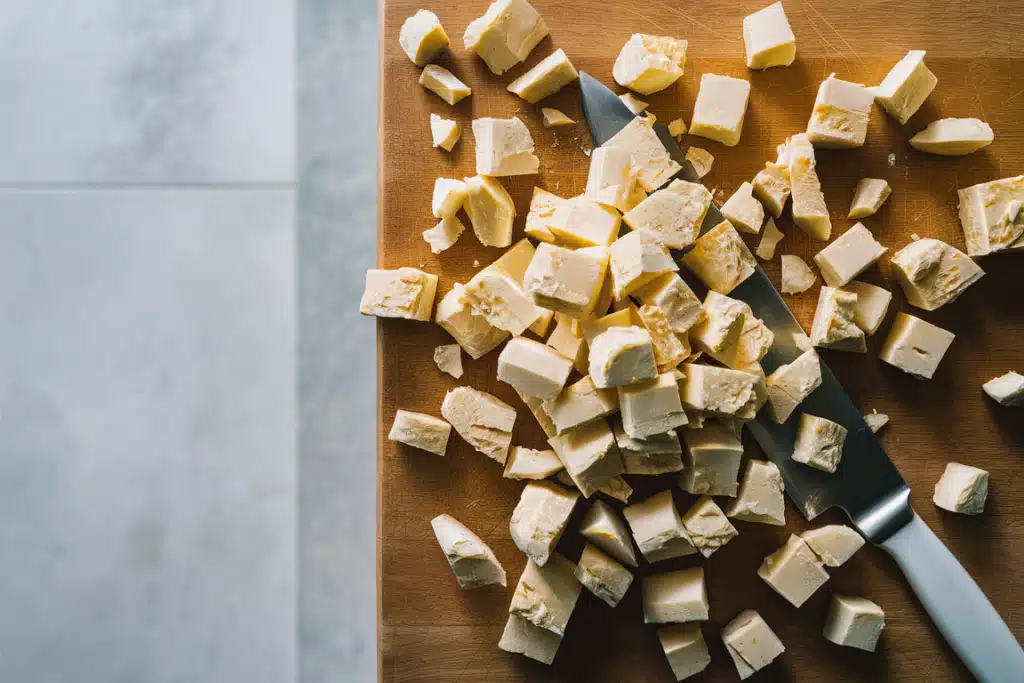
High-quality raw cacao butter forms the foundation of vegan white chocolate. This pure, food-grade butter comes from cacao beans. It gives white chocolate its smooth, creamy texture that makes it irresistible. Always choose unrefined, food-grade cacao butter for the best results.
Plant-based Milk Options
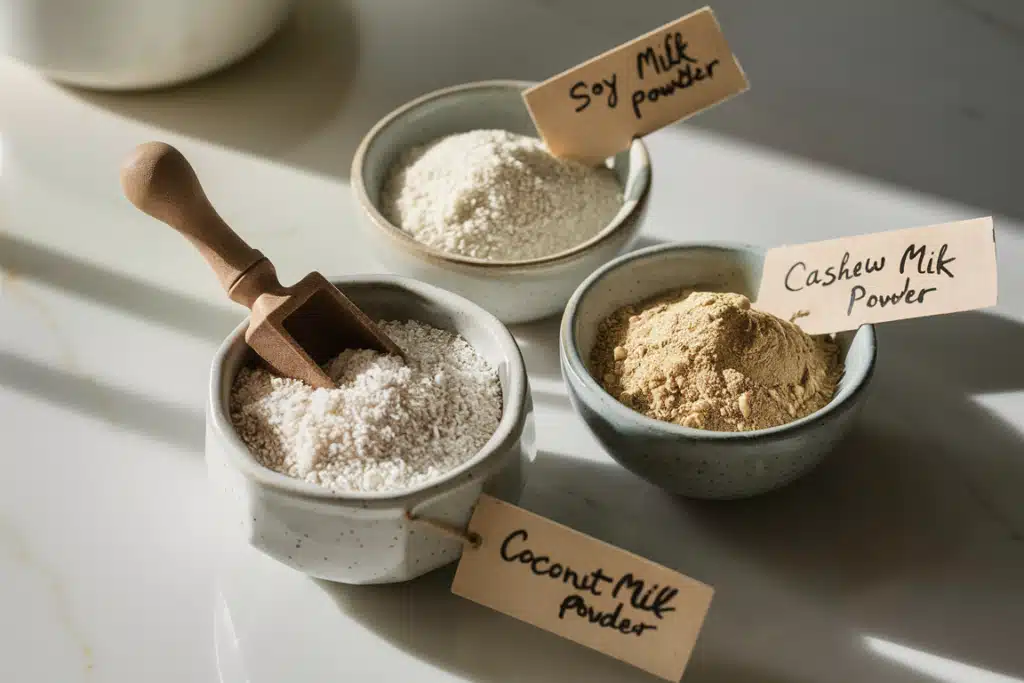
Select from these dairy-free alternatives:
- Coconut milk powder: Creates the creamiest texture
- Soy milk powder: Adds protein and a neutral taste
- Cashew milk powder: Offers subtle nutty notes
Natural Sweeteners
The right sweetener ensures perfect taste without graininess:
- Powdered sugar: Dissolves easily and provides smooth texture
- Pure maple syrup: Adds depth while maintaining proper consistency
- Coconut sugar (finely ground): Offers caramel notes
Vanilla Extract Importance
Pure vanilla extract is crucial for authentic white chocolate flavor. It adds depth and masks any plant-based notes from alternative milk powders. Always use pure extract rather than artificial flavoring for the best taste profile.
Optional Flavor Enhancers
Elevate your white chocolate with:
- Soy lecithin: Improves emulsion and texture
- Sea salt: Balances sweetness
- Tapioca starch: Helps with setting
- Natural extracts: Mint, almond, or orange
Now that you know the key parts, let’s look at the kitchen tools you need. These tools will help you turn these ingredients into tasty vegan white chocolate.
Kitchen Tools Needed
Double Boiler Setup
A proper double boiler setup is crucial for melting cacao butter without burning it. You can either use a dedicated double boiler or create one by:
- Placing a heat-safe glass or metal bowl on top of a saucepan
- Ensuring the bowl doesn’t touch the simmering water below
- Using a bowl that fits snugly without letting steam escape
Thermometer Basics
Temperature control is essential for perfect vegan white chocolate. You’ll need:
- A candy or digital thermometer that reads between 80-120°F (27-49°C)
- An infrared thermometer for quick surface temperature readings
- A thermometer with a metal probe for accurate measurements
Molds and Containers
Select appropriate molds based on your intended use:
- Silicone chocolate molds for professional-looking pieces
- Bar molds for traditional chocolate bars
- Small candy molds for bite-sized treats
- Flexible ice cube trays as budget-friendly alternatives
- Parchment-lined containers for chocolate bark
All tools should be completely dry before use, as water can cause your chocolate to seize. Having these essential tools ready ensures a smooth chocolate-making process. Now that your workspace is properly equipped, let’s explore the step-by-step process of creating your vegan white chocolate.
Making Process
Melting Techniques
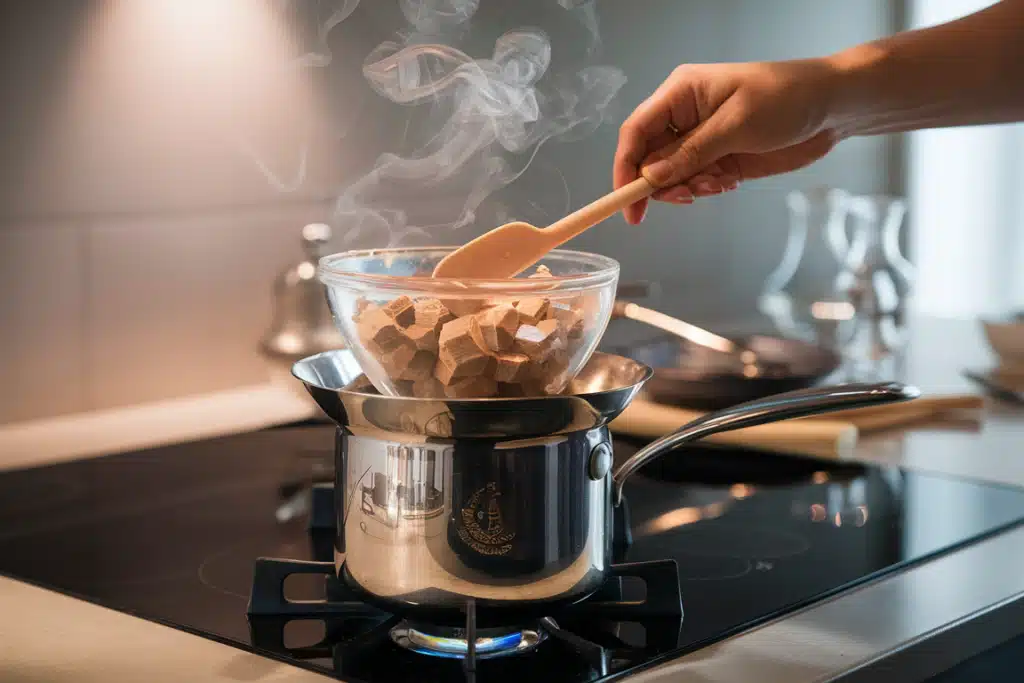
To create silky-smooth vegan white chocolate, proper melting of cocoa butter is crucial. Begin by chopping the cacao butter into small, uniform pieces to ensure even melting. Use a double boiler method by placing a heat-safe bowl over simmering water, keeping the bottom of the bowl from touching the water. Never melt directly over heat, as this can burn the delicate ingredients.
Temperature Control
Maintaining the right temperature is vital for achieving the perfect texture. Heat the cacao butter to 113°F (45°C), then add coconut milk powder and powdered sugar. Keep the temperature between 88-90°F (31-32°C) while mixing to ensure proper crystallization. Use a chocolate thermometer for accuracy.
Mixing Method

Follow these critical steps for proper mixing:
- Add ingredients gradually while stirring constantly
- Incorporate soy lecithin to help bind oils and powders
- Mix until completely smooth with no visible particles
- Avoid introducing water, which can cause seizing
Molding Tips

Pour the melted chocolate into tempered molds, ensuring they’re completely dry and at room temperature. Here’s how to achieve professional results:
- Tap molds gently to remove air bubbles
- Scrape excess chocolate off the mold’s surface
- Keep molds level during setting
- If using silicon molds, place them on a firm surface
Now that your chocolate is properly prepared and molded, let’s explore the crucial steps for proper storage and setting to ensure the best results.
Storage and Setting
Cooling Time Guidelines
For perfectly set vegan white chocolate, follow these crucial timing guidelines:
- Initial cooling: Let stand at room temperature for 15-20 minutes
- Refrigeration: Minimum 2 hours for firm texture
- Full setting: 4-6 hours for optimal crystallization
- Quick setting: 30-45 minutes in the freezer (though not recommended for best texture)
Storage Conditions
Proper storage is essential for maintaining the quality of your homemade vegan white chocolate:
- Temperature: Keep between 65-70°F (18-21°C)
- Container: Store in an airtight container or wrapped in foil
- Light exposure: Keep away from direct sunlight
- Humidity: Store in a dry environment to prevent sugar bloom
- Separate storage: Keep away from strong-smelling foods
Shelf Life Details
When stored properly, your vegan white chocolate will maintain its quality:
- Room temperature: 1-2 weeks
- Refrigerated: Up to 1 month
- Freezer: 3-6 months (though texture may change slightly)
Signs of spoilage include:
- White or gray spots on the surface
- Off-putting odor
- Changed texture or softness
- Discoloration
Now that you know how to store it properly, let’s look at some fun recipe ideas. These will make your vegan white chocolate even more exciting.
Recipe Variations
Flavor Additions
Transform your basic vegan white chocolate into gourmet treats with these exciting flavor combinations:
- Matcha powder for an earthy Japanese-inspired chocolate
- Freeze-dried raspberry powder for a fruity kick
- Pure vanilla bean paste for intense vanilla notes
- Ground cardamom and rose water for Middle Eastern flair
- Espresso powder for a sophisticated mocha blend
Color Alternatives
Create visually stunning chocolates while maintaining the vegan integrity:
- Natural food coloring powders derived from plants
- Butterfly pea powder for blue hues
- Beet powder for pink and red shades
- Turmeric for golden yellow tones
- Spirulina for natural green coloring
Texture Modifications
Enhance your vegan white chocolate with various texture elements:
- Crushed freeze-dried fruits
- Toasted chopped nuts (almonds, hazelnuts, or macadamia)
- Crunchy cacao nibs
- Shredded coconut
- Puffed quinoa for a crispy texture
Shape Suggestions
Get creative with presentation using different molding techniques:
- Classic bar molds for traditional chocolate bars
- Silicon truffle molds for bite-sized treats
- Praline shapes for elegant gifting
- Fun seasonal shapes for holidays
- Mini cup molds for white chocolate cups
Now that you’ve seen these creative options, let’s discuss why making vegan white chocolate at home is better than buying it.
Why Make Vegan White Chocolate at Home?
Benefits vs. Store-Bought
Making vegan white chocolate at home offers several compelling advantages over store-bought alternatives:
- Complete ingredient control – you choose high-quality, organic ingredients without unnecessary additives or preservatives
- Cost-effectiveness when making larger batches
- Customizable sweetness levels to match your preferences
- Fresh, authentic taste without artificial flavors
- Freedom to experiment with different ingredients like coconut milk powder or cashew butter
Ethical and Environmental Considerations
Creating homemade vegan white chocolate aligns with conscious consumption and environmental responsibility. Key benefits include:
- Reduced packaging waste compared to store-bought chocolate bars
- Lower carbon footprint by avoiding mass production and transportation
- Support for sustainable cacao butter sourcing
- Control over ingredient sourcing to ensure fair trade practices
- Elimination of palm oil commonly found in commercial white chocolate
When you use organic cacao butter and natural sweeteners, you make a healthier treat. You also support sustainable farming practices. The ability to choose eco-friendly packaging for storage further reduces environmental impact.
Making vegan white chocolate at home is surprisingly easy. You only need a few key ingredients and some basic kitchen tools. Now, let’s explore the essential ingredients you’ll need to create your own delicious vegan white chocolate.
Ingredients You’ll Need
List of the Five Main Ingredients
The foundation of homemade vegan white chocolate relies on these essential components:
- Cacao butter (4 ounces) – The primary ingredient that gives white chocolate its distinctive texture and mouthfeel
- Coconut milk powder (1 cup) – Provides the creamy, milky taste without dairy
- Powdered sugar (1/2 cup) – Adds sweetness and helps with texture
- Vanilla extract (1 teaspoon) – Enhances flavor depth
- Soy lecithin (1/4 teaspoon) – Acts as an emulsifier for smooth texture
Notes on Ingredient Quality and Substitutions
Quality matters significantly when making vegan white chocolate:
- Cacao butter: Use food-grade, deodorized cacao butter for the best results. Coconut oil can work as a substitute but will result in a softer chocolate that melts more easily.
- Coconut milk powder: Choose a brand without added casein. If unavailable, cashew powder makes an excellent alternative.
- Powdered sugar: Ensure it’s vegan-certified, as some brands use bone char in processing. Liquid sweeteners won’t work as they can cause the chocolate to seize.
- Vanilla extract: Pure extract offers superior flavor compared to artificial versions. Vanilla bean paste can be used for intense flavor.
- Soy lecithin: While optional, it significantly improves texture. Sunflower lecithin works as an alternative for soy-free versions.
Now that you understand the ingredients, let’s explore the essential equipment needed for making your vegan white chocolate.
Equipment Required
Essential Tools
- Double boiler or heat-safe bowl with pot
- Digital thermometer (candy or chocolate thermometer)
- Silicone spatula or wooden spoon
- Chocolate molds or parchment-lined baking sheet
- Measuring cups and spoons
Optional Equipment for Best Results
- Food processor or high-speed blender
- Fine-mesh strainer
- Digital kitchen scale
- Tempering machine
- Immersion blender
Making vegan white chocolate requires precise temperature control and proper tools to achieve that perfect, professional-quality result. The double boiler setup is important. It stops direct heat from burning your cacao butter and other ingredients. If you don’t have a dedicated double boiler, simply place a heat-safe glass bowl over a pot of simmering water.
A digital thermometer is non-negotiable for maintaining the correct temperature range (110-115°F) during melting and tempering. This ensures your white chocolate will have that satisfying snap and glossy finish. Use a silicone spatula to gently stir ingredients without introducing air bubbles.
While optional, a food processor helps achieve a smoother texture when incorporating dry ingredients like coconut milk powder. A digital scale provides more accurate measurements than cups, especially for ingredients like cacao butter. An immersion blender can help create a silky-smooth emulsion, particularly when working with ingredients like soy lecithin.
Now that you have your equipment ready, let’s move on to the step-by-step instructions for creating your homemade vegan white chocolate.
Step-by-Step Instructions
A. Prepare Your Ingredients
Before starting, ensure all ingredients are accurately measured and at room temperature:
- 200g cocoa butter, chopped into small pieces
- 1 cup coconut milk powder
- 1/2 cup powdered sugar
- 1 tsp soy lecithin
- 1 tsp vanilla extract
B. Melt the Cocoa Butter
Place the chopped cocoa butter in a heat-safe bowl over a double boiler. Heat on medium-low, stirring occasionally until completely melted (around 110°F/43°C). Remove from heat immediately to prevent burning.
C. Mix in the Remaining Ingredients
Gradually add coconut milk powder while whisking continuously to prevent lumps. Add powdered sugar, followed by soy lecithin and vanilla extract. Blend thoroughly until the mixture is completely smooth and silky.
D. Pour and Set the Chocolate
Pour the mixture into prepared chocolate molds or a lined baking dish. Tap gently against the counter several times to remove air bubbles. For a professional finish:
- Ensure molds are completely dry and clean
- Pour in a steady stream
- Fill molds about 90% full
- Tap molds 5-6 times
E. Enjoy Your Homemade Treat
Let the chocolate sit at room temperature for 1 hour. Then, move it to the refrigerator for 2-3 hours until it is completely firm. Once set, carefully remove from molds.
Now that your vegan white chocolate is ready, let’s look at some fun flavor ideas and add-ins to make it your own.
Tips for the Perfect Vegan White Chocolate
Ingredient Selection Tips
For creating flawless vegan white chocolate, selecting high-quality ingredients is crucial. Use food-grade cacao butter that’s light yellow in color and has a subtle chocolate aroma. Choose organic coconut milk powder that’s free from additives and ensure your powdered sugar is vegan-certified.
Common Mistakes to Avoid
When making vegan white chocolate, steer clear of these common pitfalls:
- Using wet utensils or allowing water contact with melted cacao butter
- Overheating the cacao butter beyond 110°F (43°C)
- Skipping the soy lecithin, which is essential for proper emulsification
- Adding liquid sweeteners instead of powdered alternatives
- Rushing the tempering process
Enhancing Texture and Flavor
To achieve professional-quality texture and taste:
- Double-sift your powdered ingredients to prevent graininess
- Add a pinch of salt to enhance sweetness
- Include vanilla extract at the end of mixing to preserve flavor
- Temper the chocolate properly for a satisfying snap and shine
- Consider adding soy lecithin for smoother consistency
The key to success lies in maintaining precise temperature control throughout the process. Use a reliable candy thermometer and work in a cool, dry environment. If your chocolate seems too thick, gradually add small amounts of melted cacao butter until reaching the desired consistency.
Now that you know how to make vegan white chocolate, let’s look at some fun flavor ideas and add-ins to personalize your treat.
Flavor Variations and Add-Ins
Nut and Seed Additions
Transform your homemade vegan white chocolate into a gourmet treat by incorporating:
- Toasted almonds, hazelnuts, or macadamia nuts (roughly chopped)
- Pumpkin seeds or sunflower seeds for a nutritious crunch
- Crushed pistachios for a beautiful green contrast
- Cashew pieces that complement the creamy texture
Fruit Infusions
Create fruity variations by adding:
- Freeze-dried raspberry or strawberry powder for natural color and flavor
- Dried cranberries or blueberries (finely chopped)
- Candied orange peel for a citrusy twist
- Dried coconut flakes for tropical notes
Spices and Extracts
Enhance your vegan white chocolate with these flavoring options:
- Pure vanilla extract for classic depth
- Matcha powder for an earthy Japanese twist
- Ground cardamom or cinnamon for warmth
- Peppermint extract for holiday treats
- Rose water for floral notes
Decorative Options
Add visual appeal with these finishing touches:
- Edible flower petals
- Colored cocoa butter swirls
- Gold or silver edible dust
- Natural food coloring for pastel hues
When adding solid ingredients, ensure they’re completely dry to prevent moisture from affecting the chocolate’s texture. For best results, incorporate powdered add-ins during the melting process and sprinkle larger pieces just before setting. Remember to adjust the amount of coconut oil when using powder-based additions to maintain the proper consistency.
Now that you’ve explored these creative variations, let’s address some common questions about making vegan white chocolate at home.
Frequently Asked Questions
Can I Use a Different Sweetener?
Yes, you can experiment with different sweeteners in your vegan white chocolate. Powdered sugar works best for texture, but you can use monk fruit sweetener or stevia powder. Avoid liquid sweeteners like maple syrup or agave as they can cause the chocolate to seize.
How Do I Store Vegan White Chocolate?
Store your homemade vegan white chocolate in an airtight container at room temperature for up to 2 weeks. For longer storage:
- Keep in the refrigerator for up to 2 months
- Store in the freezer for up to 6 months
- Always protect from moisture and heat
- Use parchment paper between layers if stacking
Can I Make This Recipe Sugar-Free?
Absolutely! Replace powdered sugar with powdered erythritol or monk fruit sweetener in a 1:1 ratio. Ensure the alternative sweetener is finely ground to prevent graininess in your chocolate.
What If My Chocolate Is Grainy?
Grainy texture usually occurs when:
- The cocoa butter wasn’t properly tempered
- The sweetener wasn’t fine enough
- The mixture was overheated
To fix this, gently remelt the chocolate and strain through a fine-mesh sieve before resetting.
Is There a Substitute for Cocoa Butter?
While cocoa butter provides the best results, you can substitute with:
- Refined coconut oil (though the chocolate will be softer)
- Vegetable shortening
- A blend of coconut oil and cashew butter
Now that we’ve addressed common concerns, let’s explore the health benefits of choosing vegan white chocolate.
Health Benefits of Vegan White Chocolate
Dairy-Free Advantages
Making vegan white chocolate at home offers significant benefits for those who avoid dairy products. Without milk solids, this treat is naturally lactose-free and easier to digest. It’s particularly beneficial for:
- People with lactose intolerance
- Those following a plant-based lifestyle
- Individuals with milk allergies
Antioxidant Properties of Cocoa Butter
While traditional white chocolate lacks the antioxidants found in dark chocolate, cocoa butter still provides notable health benefits:
- Rich in polyphenols that fight free radicals
- Contains natural fatty acids that support heart health
- Provides vitamin E for skin health and immune function
Lower Sugar Options
Homemade vegan white chocolate allows complete control over sweetness levels. You can:
- Use natural sweeteners like powdered coconut sugar
- Reduce overall sugar content
- Incorporate sugar-free alternatives for diabetic-friendly options
Allergen Information
This dairy-free version eliminates common allergens found in commercial white chocolate:
- Free from milk proteins
- Can be made without soy lecithin
- Easily adaptable for nut-free diets
- Gluten-free by nature
Now that you know the health benefits of homemade vegan white chocolate, let’s look at some fun serving ideas to enjoy it.
Serving Suggestions
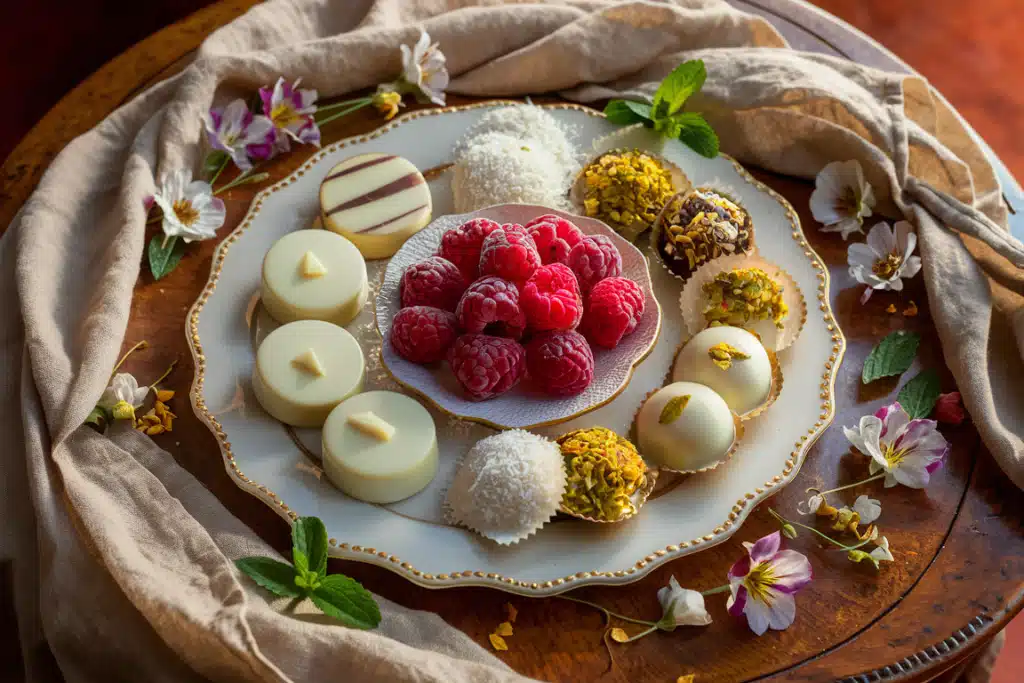
As a Standalone Snack
Break your homemade vegan white chocolate into bite-sized pieces for a delightful snack. Store them in a small container at room temperature for easy access when cravings strike. For an elevated experience, pair these creamy morsels with:
- Fresh berries
- Roasted nuts
- Dried fruit
- A cup of hot herbal tea
In Baking and Desserts
Transform your vegan white chocolate into spectacular dessert creations. Here are some creative ways to incorporate it:
- Chop into chunks for cookies or brownies
- Melt for drizzling over vegan cakes or cupcakes
- Use as a coating for energy balls
- Blend into vegan cheesecake filling
- Add to homemade trail mix
Gourmet Gifting Ideas
Your homemade vegan white chocolate makes for thoughtful and impressive gifts. Present them in style with these suggestions:
- Package in clear cellophane bags with elegant ribbons
- Create custom chocolate bars with embedded dried flowers
- Make chocolate-covered strawberries
- Design gift boxes with assorted flavored pieces
- Pair with other homemade vegan treats
Now that you know how to serve your vegan white chocolate, let’s answer some common questions about making and storing it.
Conclusion
Recap of Recipe Highlights
Creating vegan white chocolate at home is a rewarding experience that puts you in control of your ingredients. This easy recipe turns simple ingredients like cacao butter, coconut milk powder, and powdered sugar into a delicious treat. It rivals store-bought options. The beauty lies in its simplicity – just 5 core ingredients and minimal equipment deliver professional-quality results.
Key advantages of this recipe include:
- Complete control over sweetness levels
- No artificial additives or preservatives
- Cost-effective compared to store-bought vegan white chocolate
- Customizable with various flavor additions
Encouragement to Experiment and Share
Don’t be afraid to make this recipe your own. Try these creative variations:
- Mix in dried fruit for natural sweetness
- Add crushed nuts for texture
- Experiment with different extracts like almond or peppermint
- Create marbled effects with vegan dark chocolate
Your homemade vegan white chocolate can be used in countless ways – from simple chocolate bars to elaborate dessert decorations. Each batch is an opportunity to perfect your technique and discover new flavor combinations.
This recipe is easy and delicious. It works for both experienced chocolatiers and curious beginners. You can make dairy-free white chocolate with it. Share your creations with friends and family, and inspire others to explore the world of vegan chocolate making.

